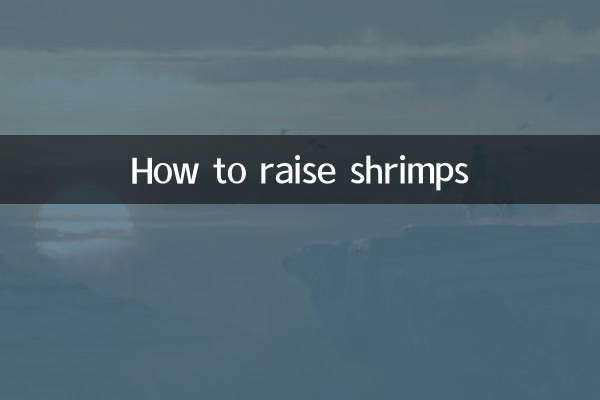How to raise shrimps
In recent years, with the rapid development of the aquaculture industry, shrimp farming has become a popular choice for many farmers and investors. This article will combine the hot topics and hot content on the Internet in the past 10 days to introduce you to shrimp farming methods in detail, including water quality management, feed feeding, disease prevention and other key aspects, to help you farm shrimp efficiently.
1. Basic conditions for shrimp farming

Shrimp farming has high requirements on water quality, environment and technology. The following are the basic conditions for shrimp farming:
| project | Require |
|---|---|
| water quality | pH value 7.5-8.5, dissolved oxygen ≥5mg/L, ammonia nitrogen ≤0.5mg/L |
| water temperature | 25-30℃ (depending on shrimp species) |
| pond depth | 1.5-2 meters is appropriate |
| Breeding density | Stocking 50,000-100,000 shrimp per mu (adjusted according to shrimp species) |
2. Steps and methods of shrimp farming
1.pond preparation
Ponds need to be thoroughly cleaned and disinfected before breeding. Remove silt and weeds, disinfect with quicklime or bleach, and fill with water after 7-10 days of exposure.
2.Shrimp seedling selection and stocking
Choose healthy, lively shrimp seedlings to avoid individuals that carry germs. When stocking, pay attention to the water temperature difference not exceeding 2°C. You can first put the shrimp bag into the pond to adapt for 30 minutes.
| Shrimp seeds | suitable temperature | Breeding cycle |
|---|---|---|
| Penaeus vannamei | 28-32℃ | 3-4 months |
| Macrobrachium rosenbergii | 25-30℃ | 5-6 months |
| prawns | 20-28℃ | 4-5 months |
3.Feed feeding management
Shrimp feed should be high-quality compound feed, and the feeding amount should be adjusted according to the growth stage of the shrimp and the water temperature. Generally, a "small amount and many times" feeding method is adopted, feeding 3-4 times a day.
| Shrimp body length (cm) | Daily feeding amount (% of body weight) | Feeding times |
|---|---|---|
| 1-3 | 8-10% | 4 times |
| 3-5 | 5-7% | 3 times |
| 5 or more | 3-5% | 2-3 times |
4.water quality management
Regularly test water quality indicators to keep water bodies clean. Change about 1/3 of the water every week and use an aerator to maintain sufficient dissolved oxygen. Appropriate amounts of aquatic plants can be planted to regulate water quality.
5.Disease prevention and treatment
Common shrimp diseases include white spot disease, red body disease, ciliate disease, etc. Focus on prevention, disinfect regularly and maintain good water quality. Diseased shrimp should be isolated and treated promptly if they are found.
| Disease name | symptom | Prevention and control methods |
|---|---|---|
| Vitiligo | White spots appear on the body surface | Improve water quality and disinfect with povidone-iodine |
| red body disease | Shrimp body red | Feed antibiotic feed and disinfect water |
| Ciliosis | White floc attached to shrimp body | copper sulfate solution bath |
3. Precautions for shrimp farming
1. During the breeding process, the growth of shrimp should be checked regularly and the breeding density should be adjusted in time.
2. Avoid using illegal drugs and strictly abide by the drug withdrawal period.
3. Pay attention to weather changes and take preventive measures before and after heavy rains.
4. Establish a breeding log to record water quality, feeding, medication, etc.
4. Harvest and Sales
The shrimp are harvested when they reach commercial size. Fishing in batches can be used to catch the big ones and leave the small ones. Stop feeding for 1-2 days before harvesting. Sales channels can be wholesale markets, catering companies or e-commerce platforms.
Shrimp farming is a highly technical industry that requires farmers to continuously learn and accumulate experience. Through scientific management and precise operation, shrimp farming can achieve good economic benefits. I hope this article is helpful to your shrimp farming practice.

check the details

check the details